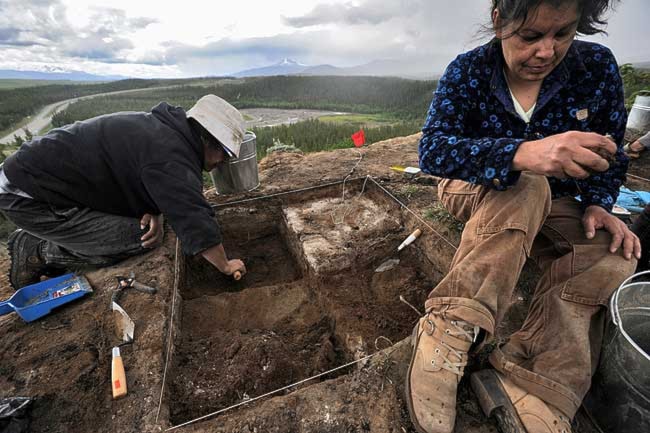On top of the clay cliffs overlooking the Whitehorse dam, a group of Yukon College students is sifting through ancient history.
Students in the heritage and culture program hope to find evidence left behind by the people who walked these hills thousands of years ago.
“If you look at the spot itself, it’s the ideal place for fishing, hunting, because you have a view of the river below,” said instructor Victoria Castillo. “It’s pretty open, and that would have been the same thousands of years ago.”
The cliff side provides clues to the history of the site. Layers of dirt deposited over millennia give a sort of road map to students trying to uncover its secrets.
Castillo pointed out a white layer, only inches below the surface, and explained that ash was deposited there when a volcano exploded off the Alaska coast 1,200 years ago.
Below that, layers of soil with yellow and red tints take us further into the past.
It’s the red layers that are the most interesting, Castillo explained, because that colouring indicates that there were plants growing in the soil at that time. The decomposed organic material suggests that animals and humans were likely around as well.
And over a metre below the surface, silver-grey compacted clay is evidence of an ancient lake.
That’s where the students will end their search for traces of their ancestors.
The college’s heritage and culture program came out of a collaboration between the Yukon First Nation Heritage Group, Yukon College and the territorial government.
The group wanted a training program designed specifically for people working for the heritage departments of First Nations governments, but who have had little or no formal training, Castillo said.
[image2]
This is the second year that the college has offered the program. Last year three students graduated with a heritage and culture certificate, and five are expected to graduate this year.
The certificate can be used to transfer into anthropology or related programs at Canadian universities.
The five students participating in the field school all belong to Yukon First Nations, and many already have jobs related to heritage.
All of the courses, besides the field studies, are offered through teleconferencing so that students can continue to live and work in their communities while they attend school.
But for four weeks in the summer, the students come together to put their new skills to the test.
On Monday the spectacular views from atop the cliff faded as storm clouds rolled in.
Five students hunkered under rain jackets and garbage bags, peeling away layers of dirt with trowels in search of evidence of past human life.
“Working in the rain is probably the most difficult part,” said student Kaylie-Ann Hummel.
Hummel, 20, is from Mayo and works as a language technician for the Na-Cho Nyak Dun First Nation. She’s taking the course so she can bring more knowledge and skills to her work in the heritage department.
She did an archeological dig with her First Nation last year, and that got her interested in learning more about it.
She will be able to take the knowledge she has gained back to her job right away, Hummel said.
Her first project when she gets back will be to map out the cabins on the Na-Cho Nyak Dun traditional territory, a skill the students will learn in the next few weeks.
For Hummel, the digging process requires a lot of patience, but it can be rewarding.
“The most exciting part was finding stuff, but we haven’t been finding very much,” Hummel said.
At the class’ previous dig site, near F. H. Collins Secondary School, they found flakes of obsidian that had been cut away to make tools.
That was a cool discovery, Hummel said, because the obsidian they found is not native to the Yukon, and would have to have been traded in.
Castillo, the instructor, said she’s surprised that the group has not yet found any artifacts at the new site overlooking the river.
The spot was picked both for its auspicious location and because previous tests done by the Yukon government have come up with evidence of past human life.
“You would assume that people would be sitting here waiting for animals to go through, and while they were waiting they would be making tools, and while they were making tools they would leave all the debris from tool production,” Castillo said.
So far they’ve found nothing on the site aside from some burnt bones, which could be from a forest fire as easily as they could be from a cook fire.
“You have to be really patient with this,” Castillo said.
For now, she and the students will have to keep digging.
Contact Jacqueline Ronson at
jronson@yukon-news.com
